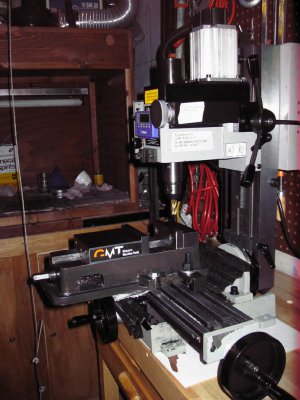After a week or so of getting pretty consistent results, suddenly my mill cuts changed by 0.003".
I calibrate my i-Gaging type Z-axis scale before use by touching it to my Fowler 1" electronic gauge, set behind the fixed jaw of my Glacern 4" vise. I've adjusted the calibration by cutting a piece of 1/8" aluminum plate set firmly down on a parallel while clamped in the vise flat against the back jaw, and measuring the cut aluminum with a micrometer.
The back of the vise is 1.125" above the throat of the vise (bottom between the jaws), and with the gauge, it should be 2.250". The cut pieces show that the actual distance totals closer to 2.124". Or at least until tonight
I destroyed a couple of pieces I was working on tonight by cutting them too short. I thought I had been careless and mis-calibrated the Z-axis, but that checked out consistent with the above measurement. I thought that I might have not gotten the pieces tapped down firmly in the vise, so I started over again, made sure the parallel supporting the piece was trapped firmly underneath, and still got a piece cut short by the same amount. I cleaned all the chips out from the vise, the parallel, and the work piece, and set the end mill height to 0.995" above the parallel. The cut piece measured 0.992".
In other words, the height from the throat of the vise to the back + gauge is 2.121" tonight, and it was 2.124" last night. Or so it would seem. Is this possible, or am I overlooking something else? The reason I'm suspecting temperature swings is I've eliminated everything else I can think of, and the shop is noticeably colder than in recent days because the thermostat is in the upper part of the house and the shop is in the basement. The outside air is warming up, but the concrete basement actually gets colder because the furnace doesn't run much. Unfortunately, I don't have any temperature readings for the shop to back this guess.
Walt
I calibrate my i-Gaging type Z-axis scale before use by touching it to my Fowler 1" electronic gauge, set behind the fixed jaw of my Glacern 4" vise. I've adjusted the calibration by cutting a piece of 1/8" aluminum plate set firmly down on a parallel while clamped in the vise flat against the back jaw, and measuring the cut aluminum with a micrometer.
The back of the vise is 1.125" above the throat of the vise (bottom between the jaws), and with the gauge, it should be 2.250". The cut pieces show that the actual distance totals closer to 2.124". Or at least until tonight
I destroyed a couple of pieces I was working on tonight by cutting them too short. I thought I had been careless and mis-calibrated the Z-axis, but that checked out consistent with the above measurement. I thought that I might have not gotten the pieces tapped down firmly in the vise, so I started over again, made sure the parallel supporting the piece was trapped firmly underneath, and still got a piece cut short by the same amount. I cleaned all the chips out from the vise, the parallel, and the work piece, and set the end mill height to 0.995" above the parallel. The cut piece measured 0.992".
In other words, the height from the throat of the vise to the back + gauge is 2.121" tonight, and it was 2.124" last night. Or so it would seem. Is this possible, or am I overlooking something else? The reason I'm suspecting temperature swings is I've eliminated everything else I can think of, and the shop is noticeably colder than in recent days because the thermostat is in the upper part of the house and the shop is in the basement. The outside air is warming up, but the concrete basement actually gets colder because the furnace doesn't run much. Unfortunately, I don't have any temperature readings for the shop to back this guess.
Walt


